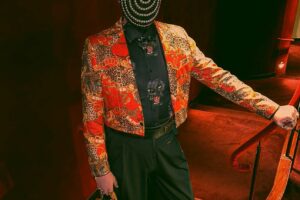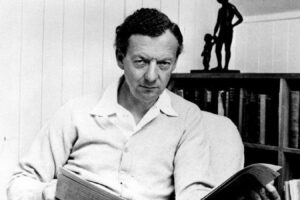

Unfortunately, Gluck ruined the effect of his flawless melody, so exquisitely prefigured in the mourning chorus that opens his opera, so superbly sited to crown a dramatic ascent through resolve to quest to triumph to disaster, by tacking on a tacky happy ending. The gods, having set Orpheus a supreme test (in the myth, it is a test of human faith in the word of the gods), tell him they were only kidding. Of course he can have his girl back, faith or no faith, promise or no promise! Can’t we have those we love back, if we just sing well and love them enough?
Well, no, we can’t. Sorrow cuts no ice with the eternal powers, actually (genuinely existing or otherwise), the dead are dead, and Gluck’s ending is a cheap lie. Gluck seemed to sense this in his uninspired aria for Love’s change of mind, which is followed (before a jolly concluding chorus) by a very long suite of rejoicing dances. In France before the Revolution, dance was as important in opera as singing.
Just because Gluck had eliminated the many tedious subplots that clutter so many early operas did not excuse him the dances. Dance there had to be and plenty of it, but his “reform” theories meant it had to belong to the story, not just shepherds and shepherdesses gadding about for the hell of it. Gluck wrote a lot of fine, lively music in contrasting rhythms for this section of the piece and it is easy for choreographers to be carried away by it all. They sometimes seem to forget what story they are telling, or that there is one to be told. (It’s all over by this time of the evening, right?)
Should Orpheus and Eurydice, then, be staged (if it is staged at all) as an opera with incidental dances or as a ballet with a couple of solo singers plus chorus? If it is the former, you should cut a lot of the dances—great music, but just not germane. If it is a ballet that you are staging, where should the singers be placed, and how can they perform their roles amid the mimed scenes of Orpheus mourning, crossing the Styx, harrowing Hell, and when he meets his partner, promenading her almost home?
Should the singers stand on the sidelines while doubles mime their lines, as used to be done with Le Coq d’Or and L’Enfant et les Sortileges? Should the chorus sing from the pit while dancers represent them on stage, the most intriguing idea of the Met’s old Rolf Gerard production? And would a stripped down Orpheus, with the dances and other interpolations eliminated, move properly, movingly, into the inane happy ending? Gluck, no doubt, would be glad to revise it to suit the modern taste—for the proper price—and you know we could get the money from some foundation or other. But he’s gone where Eurydice went, and they’re not coming back.
Enter the Paris Opera Ballet, currently taking part in the Lincoln Center Festival. Or rather, enter Pina Bausch (who, dear lady, is with Gluck and Eurydice now), once a frequent visitor to BAM and, ages ago, a member of the Met’s corps de ballet, with whom she danced in Gluck’s Alceste and in Tannhäuser. Bausch created her own versions of Gluck’s Iphigénie en Tauride and Orpheus for Tanztheater Wuppertal back in 1974 and 1975, then recreated them in 1991. Inexplicably (to me), she never brought them along on her frequent visits to Brooklyn (and I’ve never forgiven her for the misbegotten Bluebeard’s Castle she did bring), but she introduced them to Paris in the nineties, and they have brought us her Orpheus at long last. (As Charon might say, “Better late than never.”)
For three of the opera’s four scenes, this is a moving, inventively staged dance-theater version of Gluck’s opera. In the final scene, though, Bausch proves her genius: She cuts the Gordian knot of Gluck’s unwieldy and unmythic storyline. And she finds a way to make this work musically that Gluck himself would surely have applauded. (In fact, his ghost appeared to me last night, after I’d written this review, and he agreed with everything I said or ever had said, theology aside. “And revive Les Danaïdes,” was his parting shot. “Salieri’s a good boy; I taught him everything I knew.”)
In the Bausch Orpheus, the opera’s three characters (Orpheus, Eurydice, Love) are played in pairs, each by a singer and a dancer. That’s her first surprise, and with singers as able at acting and movement as they are at singing, the techinque achieves sublime effects with the greatest economy. The text is sung in German and there are no surtitles which had not been invented in 1975. Who needs them? An audience attuned to ballet certainly does not. The story is basic and lovers of dance know how to follow mime and symbolic gesture. Rolf Borzik’s simple sets, costumes and lighting have been retained from the first incarnation. (The best opera I’ve attended this year has all of it been without titles.)
At curtain’s rise, dancers in black mourn to distraction, their voices seeming to rise from the pit through the stage to permeate the action. A near-naked Orpheus (wraithlike Stéphane Bullion) does not have to groan, “Eurydike!”—eloquent mezzo Maria Riccarda Wesseling, in a simple black dress, does it for him. Another dancer appears to attempt a pas de deux—but his partner does not bounce when he lifts and lowers her; she is lifeless Eurydice. A dead tree emerges from the wall and spreads its shadow on a grave site. Love (soprano Zoe Nicolaidou and dancer Muriel Zusperreguy) brings Orpheus good news: He may reclaim his love if he will go to the Underworld and not look back at her until they return to the surface.
The second scene, “Violence,” to the famous music of Orpheus’ seduction of the Furies, is set among writhing spirits (now clad in white), divided into rows by the rivers of the Underworld, tormented by endless tasks, an apple suspended just out of reach, rocks never quite rolled uphill and the three monstrous heads of Cerberus, danced by three muscular brutes in long aprons.
Orpheus sings his way through to the third scene, “Peace,” where Eurydice (sung by Yun Jing Choi, danced by Marie-Agnès Gillot) sings of the joys of the blessed and Orpheus of the purity of its skies. The Spirits, miming what he is never to do, turn back and look, reflecting movement as if in a central mirror, bring on Eurydice. Orpheus puts his hand behind him; she takes it; he leads her forward.
In the final scene, Gillot is dressed in a shivering crimson dress that sets her apart from the black-clad singers and ghostly white Orpheus. She whirls around him, entreating him to look at her, explain his coldness, share her happiness and then her despair. He trudges on, averts his eyes, stares around the stage in desperate appeal to—nothingness. Pushed beyond endurance, he gives in: He takes her in his arms; she falls limp and lifeless between them—right on top of Choi, her “singer.” Together the two Eurydices lie in a heap, lifeless. Bullion hunches at the back of the stage, his naked back motionless in grief. Wesseling, singing the role, kneels beside the “corpses.” As throughout the evening, her voice is more animate than Bullion’s dancing ever is.
We have reached the climax of the story, of the ballet—and there is no dance. The moment and that solemn, aching melody require no movement at all, a contrast to all the whirling that has preceded it. Wesseling, desolate, sings, motionless. Her tone is steady, pure, filling the Koch Theater as if she were singing lieder in an intimate space, as if she were alone. Each phrase of the rondo moves as if with Orpheus’ inner desolation: What will he do, where will he go, how will he live without his love? Answer me! (But there is no answer.) The emptiness of solitary despair is expressed in the motionlessness of the stage on which we have seen so much action in the previous two hours.
And then? Instead of the return of a cheerfully forgiving Love, instead of the jolly duet and those endless pretty dances, the mourners in black return, more ordered and professional this time. Time has passed. The dead are dead. The rites are official now. And they sing—the opening chorus of the opera, with Wesseling’s still more heartbreaking wails of “Eurydike!” interrupting the flow, unremarked because they are sung within the breaking heart. Upstage, Orpheus, crouched in grief, does not move at all. Death is eternal.
I must say a word or two about Choi’s moving, eloquent Eurydice and more than one about the Balthasar-Neumann Ensemble-und-Chor, led on opening night by their founder, Thomas Hengelbrock. The chorus is small and precise: Each voice making its effect in the subtle fabric of mourning, the outbursts of Hell, the calm of the Elysian Fields. The band specializes in the baroque repertory (up through Stravinsky!); they gave us wonderful fluttery trills from recorders, wooden flutes, pre-modern bowed strings and valveless brasses. Small, smart and clear sounds were led with precise, lively rhythms.
I thought it a fine, creative performance of a wonderful score until the second death of Eurydice and the aria of Orpheus. Then I was shocked and profoundly moved. Having set me up, Pina Bausch drove me home: She concluded the opera on an unfamiliar note, as perfect to the legend as is Gluck’s score. I never want to see or hear this opera performed in any other way. We can detach the dances and give them to some other choreographer to play with.
Photos: Lincoln Center Festival





























Comments